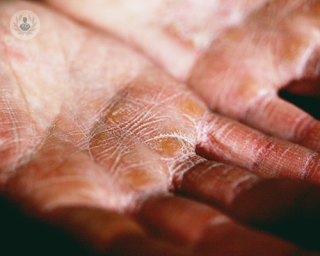Allergic atopic dermatitis
Professor Helen Brough - Paediatric allergy & immunology
Created on: 11-13-2012
Updated on: 11-28-2023
Edited by: Conor Lynch
What is allergic atopic dermatitis?
Allergic atopic dermatitis is a chronic inflammatory skin condition that affects millions of people worldwide. It is characterised by dry, itchy, and inflamed skin that can be painful and uncomfortable.

What causes allergic atopic dermatitis?
The exact cause of atopic dermatitis is unknown, but it is believed to be related to a combination of genetic and environmental factors.
What are the symptoms?
Symptoms of allergic atopic dermatitis can vary from person to person, but typically include dry, scaly patches of skin that are red and itchy. These patches can appear anywhere on the body, but are most commonly found on the hands, feet, arms, and legs. In severe cases, the skin may become thickened and leathery, and may crack and bleed.
What is the outlook for patients with allergic atopic dermatitis?
The outlook for allergic atopic dermatitis varies depending on the severity of the condition. Mild cases can often be managed with over-the-counter creams and ointments, while more severe cases may require prescription medications such as corticosteroids or immunomodulators. In some cases, phototherapy (light therapy) may also be used to treat the condition.
How is it diagnosed?
Diagnosis of allergic atopic dermatitis is typically based on a physical examination of the skin, as well as a review of the patient’s medical history. In some cases, a skin biopsy may be performed to rule out other conditions.
How is allergic atopic dermatitis treated?
Treatment of allergic atopic dermatitis typically involves a combination of lifestyle changes and medications. Lifestyle changes may include avoiding triggers such as harsh soaps and detergents, wearing soft, breathable clothing, and using a humidifier to keep the air moist. Medications may include topical corticosteroids, immunomodulators, and antibiotics.






